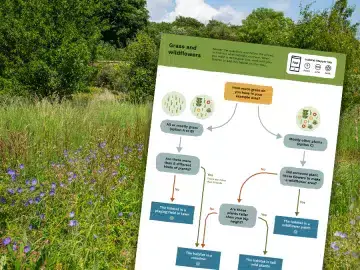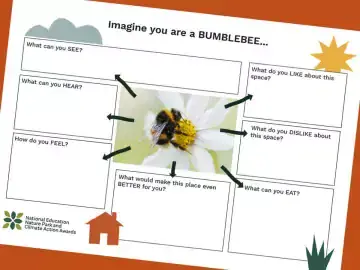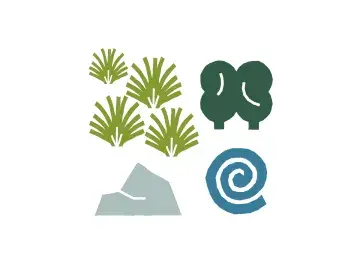
Habitat Heroes
Explore your outdoor spaces and connect to nature this spring!
Discover the homes for wildlife around your school, nursery or college site by following the prompts in this quick and fun activity. It's a great way of getting to know your outdoor spaces better before you start mapping your site, an essential first step in your Nature Park journey.
Plus, if you're registered for the programme, have created your site boundary and take part in Habitat Heroes between 22 April – 22 May 2025, you'll be entered into a prize draw to win a bundle of outdoor learning prizes! Terms and conditions apply.
Preparation
What you need
- Habitat Heroes illustrations pack
- Smartphones or tablets to map the habitats you've found on your site - alternatively, you can use the prompt sheets and add to the map here after exploring your site
- Optional: Habitat Heroes prompt sheets, clipboards and pencils
Access Habitat Heroes

EYFS-Key Stage 1
This version of Habitat Heroes doesn't require learners to type any responses - suggested for younger learner or SEND groups.

Key Stage 2+
This version asks learners to tell us about their explorations via text boxes - suggested for those more confident with reading and writing.
Scan the QR Code or use the buttons above on a phone or a tablet to open Habitat Heroes. It will automatically open in your browser. Habitat Heroes uses your location from your device, so make sure that you enable this or zoom in and add your point to the map manually.
Location
Outdoors
Useful guidance
Resources
Step by step
Part 1: Introduction
- Begin by introducing the concept of a habitat. For younger learners, take a look at our nature library catalogue for suggestions on suitable picture books that introduce the theme of habitats. For learners who may have already been introduced to the word, ask them how they would define a habitat? What is a habitat? Can they name any habitats and what they provide for the organisms that live there?
- Invite learners to explore the Habitat Heroes illustrations. This could be with small groups each looking at a different habitat, or as a class together – depending on where you deliver this activity, these could be displayed on a screen or printed and handed out.
- Ask learners to look closely at the different scenes, and prompt them to point out differences, similarities, or name living things they can see. (See Activity Guide for more suggestions)
Part 2: Be a Habitat Hero!
- Exploring your outdoor space, ask learners to think about the habitats they have just seen, and whether they have any spaces like this around their site.
- Using the Habitat Heroes survey on a smartphone or tablet or the printable prompt sheets, learners will be prompted to find ‘a place that is good for’: bumblebees and butterflies, birds, worms, spiders, frogs, hedgehogs, or slugs and snails. Remind learners that it’s okay if they can’t find the living thing itself – we are looking for places the wildlife might enjoy or may usually be found!
- Learners can then add a photo of the space they’ve found to the survey. If using the prompt sheets, learners may wish to draw a picture of the space they have found on the reverse, or on a plain sheet of paper. The KS2 survey and prompt sheet includes additional questions about the space. For younger groups, you may wish to discuss these questions as a class instead.
Reflection
These discussion prompts can help you to reflect on what you found together, and how you could use this information to help you in your Nature Park journey:
- Did you see any living things in these places? If you didn’t, why might that be?
- Were there any places for wildlife you couldn’t find?
- What could we do to improve these places for wildlife?
- What would you do in this place? Is it a place you’d want to spend time in?
Once you’ve completed the challenge, download and print our Habitat Heroes certificates to recognise learners’ findings, and social media posts to share your participation!
Please note: If you'd like to see your entries on the map as soon as possible, you can now verify your own learners' submissions via the Habitat Heroes Verification Tool. To access the tool, make sure you are logged in to the Nature Park website. If you are presented with a log-in screen, click the big blue button to take you to the Nature Park Community. Follow the on-screen instructions to verify your school's submissions and enable them to be shown or hidden from the public map, and delete any unsuitable images as necessary. If you are not able to verify your own submissions, members of the Nature Park team will be verifying submissions less frequently.
In your next session, explore the map to see your contributions, and take a look at what others have discovered around the country!
Curriculum links
This activity can be used to support curriculum knowledge and skill development in science, alongside enhancing nature education, with age appropriate adaptations.
What to try next

Mapping your site
Begin activity
Points of view
Begin activity
Habitats
Begin activityThumbnail image: © Habitat Heroes illustrations by Lizzie Lomax for National Education Nature Park